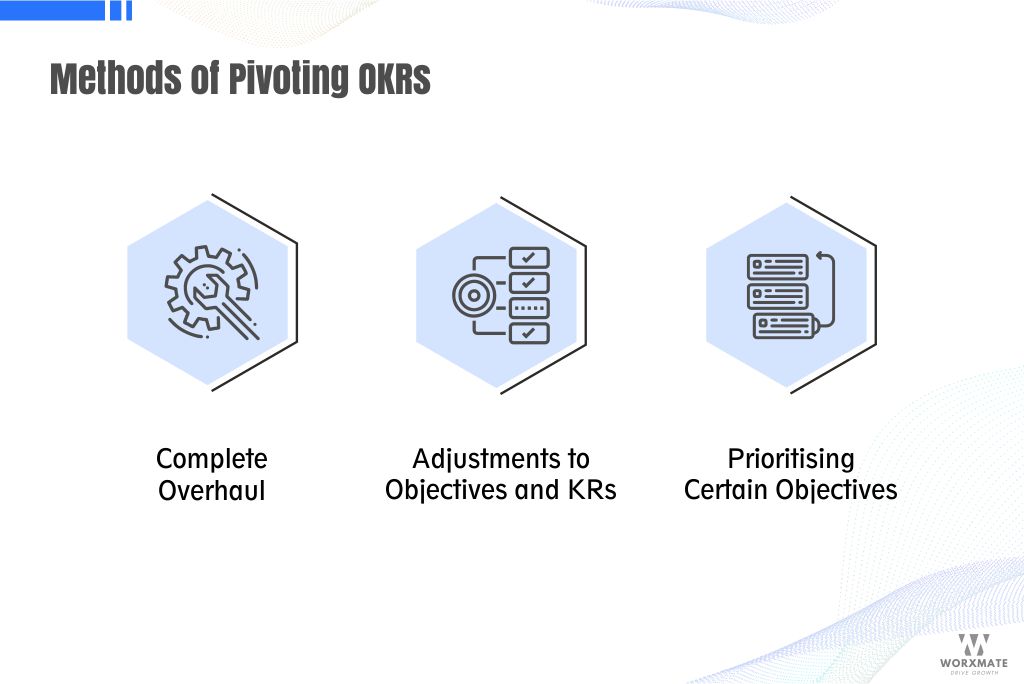- Product
Deep AI
Define, execute, evaluate and plan your OKR journey
OKR Solution
Discover focus, alignment and celebrate success
Task Management
Prioritize, plan, and deliver tasks effectively
Join leading organizations relying on Worxmate for efficient OKR management and success
Deep AI
Define, execute, evaluate and plan your OKR journey
OKR Solution
Discover focus, alignment and celebrate success
Task Management
Prioritize, plan, and deliver tasks effectively
Join leading organizations relying on Worxmate for efficient OKR management and success
- OKR Consulting
- Pricing
- About Us
- Contact Us
- Resources
Adjusting OKRs: When and How to Pivot
- April 1, 2024
- 4 min read

OKRs have been adopted as a framework for goal setting and execution by countless businesses worldwide. Utilizing this framework to achieve goals and objectives is key to staying ahead of the competition.
But what happens when there is a shift, and the current plan no longer leads to success?


The Need for Adjustment
It is essential to understand that priorities can shift, insights can deepen, and external factors can disrupt the status quo.-
Shifting Priorities
As businesses grow and markets change, what was once a top priority may no longer hold the same significance. Adjusting OKRs ensures that objectives remain aligned with current organizational focus areas.
-
New Insights
The business landscape is dynamic, with new data and insights continually emerging. Adjusting OKRs to respond to fresh insights enables companies to capitalize on opportunities and effectively address emerging challenges.
-
Adapting to External Factors
From changes in market conditions to shifts in customer preferences, external factors can significantly impact a company’s trajectory. By adjusting OKRs, organizations can respond proactively to external changes and maintain competitiveness.
-
Signs of Ineffectiveness
Persistent failure to achieve Key Results or stagnation may indicate that OKRs need adjustment. Organizations can realign their efforts for greater impact by reassessing objectives and Key Results.
-
Monitoring Progress
Regularly tracking progress against OKRs and soliciting feedback from stakeholders can provide valuable insights into the effectiveness of current objectives. Adjustments may be necessary to ensure that OKRs remain relevant and achievable.
-
Market Dynamics
Keeping a finger on the pulse of market trends and industry shifts can help organizations anticipate changes and pivot their OKRs accordingly. This proactive approach enables companies to seize new opportunities and mitigate potential risks.
-
Encouraging Innovation and Growth
Adjusting OKRs can foster a culture of innovation by allowing teams to explore new strategies and pursue ambitious goals. By embracing change, organizations can position themselves for continued growth and success.
Time for Adjustments
Knowing when to pivot OKRs is as vital as recognizing the need for adjustment. Several factors can influence the timing of OKR adjustments.-
Regular Review Intervals
Establishing regular review cycles, such as quarterly or semi-annually, provides opportunities to assess the effectiveness of OKRs and make adjustments as needed. This proactive approach ensures that OKRs remain aligned with evolving priorities.
-
Triggers
Significant events or milestones, such as launching a new product or a strategic partnership, may trigger reevaluating OKRs. These events often signal changes in priorities or market conditions that necessitate adjustments to OKRs.
-
Monitoring Key Metrics
Tracking key performance indicators (KPIs) and other relevant metrics can provide valuable insights into the effectiveness of current OKRs. If KPIs consistently fall short or fail to reflect progress toward objectives, it may be time to pivot OKRs to set more realistic or impactful goals. It’s crucial to consider various factors that indicate whether the objectives are appropriately challenging and achievable.
-
- Consistently met KRs: If all Key Results are consistently being met, it suggests that they may not be sufficiently challenging. Achieving 100% of KRs may indicate that the goals set were too easily attainable, and as a result, the organization might not be pushing itself to its full potential.
- Less than 70% Achievement The objectives were likely overly ambitious or unrealistic if an organization consistently achieves less than 70% of its Key Results.
- Achieving 100% of KRs Constantly achieving 100% of Key Results could also indicate that the organization is not setting sufficiently ambitious goals. Setting goals that stretch the organization beyond its comfort zone is essential for driving growth and innovation.
Methods of Pivoting OKRs
When it comes to adjusting OKRs, there are several methods organizations can employ:-
Complete or Partial Adjustments
Organizations may opt for a complete overhaul of OKRs or make partial adjustments depending on the extent of the change required. While a complete overhaul may be necessary in some cases, partial adjustments can often suffice, allowing organizations to adapt to changing circumstances without starting from scratch.
-
Rewording Objectives and KRs
Simple rewording of Objectives or Key Results can better reflect evolving priorities or clarify expectations. This approach allows organizations to maintain continuity while still adapting to changing needs.
-
Adding or Removing KRs
Adding new Key Results or removing outdated ones can help refocus efforts on what matters most. This method allows organizations to realign their resources and prioritize initiatives that are most likely to drive success.
-
Prioritizing Objectives
When resources are limited, or priorities shift rapidly, prioritizing objectives can help ensure that efforts are focused on the most critical areas.

The Impact
Before making OKR adjustments, it’s essential to consider the potential impact on various aspects of the organization.-
Morale and Motivation
Changes to OKRs can significantly impact team morale and motivation. It’s essential to communicate changes effectively, address any concerns or uncertainties, and provide support to ensure team members remain engaged and motivated.
-
Maintaining Alignment
OKR adjustments should always be aligned with the overall direction and strategy of the organization. It’s crucial to ensure that changes to OKRs support broader organizational goals and priorities and do not undermine long-term objectives.
-
Communicating Changes Effectively
Transparent and effective communication is essential when adjusting OKRs. Organizations should clearly communicate the reasons for adjustment, the expected outcomes, and any changes to expectations or priorities. Organizations can minimize confusion and disruption by keeping team members informed and involved and maintaining trust and confidence in the process.

Conclusion
Adjusting OKRs is not a sign of failure but rather a testament to an organization’s ability to adapt and thrive in a rapidly changing world. By recognizing the need for adjustment, knowing when to pivot, and engaging the team in the process, organizations can ensure that their OKRs remain relevant, achievable, and aligned with their long-term goals. Embracing change as an opportunity for growth and improvement, organizations can navigate the pivot with precision and purpose, positioning themselves for continued success in the future.Share this article: